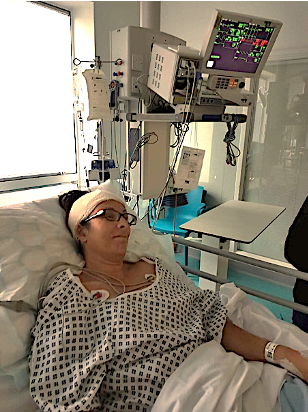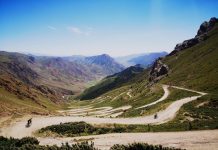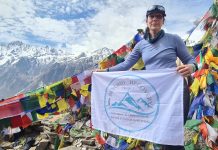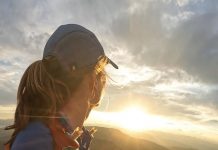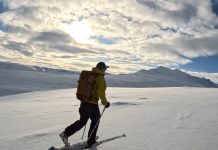In February 2018, a few months of feeling unwell, my life was turned upside down when I was diagnosed with a large, low grade but life threatening brain tumour. It was causing brainstem compression that caused all sorts of problems. My resting pulse that was normally below 60 bpm was now 110bpm. My blood pressure also soared. Walking a few steps felt like a marathon. I had no sense of taste, couldn’t see properly and a heightened sense of smell. Life became intolerable.
A few weeks before my surgery, I experienced the rare and unexpected complication of a haemorrhage. I subsequently underwent major brain surgery 3 weeks later in May 2018 that left me unable to walk, with impaired and severe double vision, nystagmus and no balance, as well as permanent profound hearing loss on one side, facial palsy, difficulty swallowing, dizziness, nausea and tinnitus. It wasn’t a pretty sight. Since that day, with support from a great bunch of people, I have been focused on getting back everything the tumour took away from me, and much more.
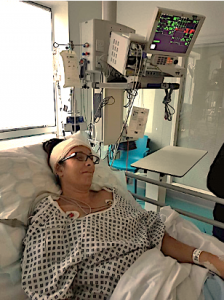
Throughout this somewhat arduous and unexpected journey, I have been fortunate enough to receive advice from fellow brain tumour warriors, along with warriors in the more traditional sense, whose mind set and positivity have taught me many valuable lessons about myself and the circumstances I found myself in.
I have learnt the importance of always looking for the positives in situations; to always look for the silver linings. Some days they are much harder to find, but look hard enough and you will always find them. I have also learnt how powerful goal setting can be.
In the early days, my goals were as ‘simple’ as getting out of bed and to a chair a metre away. Now I have bigger, longer term goals, but I never forget the small daily or weekly ones, and yes, some of those are still to get out of bed.
So, I find myself here, approaching the second anniversary of my surgery, sharing the story of how I am learning to overcome adversity to get from sickbed to summits.
As I mentioned, surgery left me with a severed hearing and balance nerve and initially unable to walk, which was not only frightening, but made the prospect of getting my active lifestyle back seemingly impossible. At that point, I realised just how long a journey this was going to be.
Determined to prove to everyone that I would get my old normal back (I still blatantly refuse to accept the new normal I was told about!) I started setting myself small, incremental goals.
It got off to a bad start… Initially, supported by two physios, we set the target of a chair a metre away from the bed. I had one of them holding me up whilst carrying my pee bag, and the other guy holding me up and pulling along the drips and monitors.
They helped me out of bed and made our first attempt. It was the most difficult thing I had ever done in my life. As I stood there, my legs simply wouldn’t move. It was as though my brain knew what I needed to do, my legs knew what they needed to do, but there was no connection. I was almost dragging my legs from my waist and hips as nothing below that point wanted to work. Covering that small distance took me 15 minutes. There were tears, and there was a lot of vomiting throughout.
As soon as I was off the HDU and disconnected from what seemed like the National Grid in terms of monitors and machines pumping me full of all sorts, I set my first goal – to get out of bed unaided and walk around the bed.
Whenever I was left alone in my room I would start work… Each step was more of a shuffle than a step and my legs felt so heavy. It was far beyond that horrible feeling of reaching your lactate threshold. Coupled with this, the good side of my brain was still trying to figure out which was up as I was down to half a balance system. I was sick each time I moved. I was on anti-sickness tablets, anti-sickness drugs through IV and wearing slow release anti-sickness patches. For days I was sick and there were concerns about blood sugar levels beginning to crash so I was then given something else for that too. I was swollen and bruised from my surgery and the numerous cannulas stuck in me.
Eventually, the shuffling got me to the bathroom door at the end of my bed, and I figured that once I was in there, I could make my way to the toilet using the various handrails fitted to the walls. With drip in tow, I made it and sat down. All of a sudden, I could hear a commotion in my room. The door burst open – I’d been busted. I was under strict instructions not to leave my bed without someone helping me. I was grinning (well half my face was grinning at least!) as I had managed to make it to the loo unaided!
I then spent the rest of my stay receiving intensive physio to get me to a point where I could get upstairs with support. My eyesight was really bad with extreme double vision to the point I was given an eye patch to give me a break from it. I also spent a bit of time learning to write again, as my brain had forgotten what to do and I was utterly shocked by the state of my illegible handwriting!
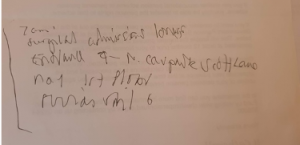
When I was first diagnosed, I felt totally lost. I had no idea what treatment lay ahead, or how I would be afterwards. The unknowns were terrifying. I was most worried that I wouldn’t be here at all and I was in some very dark places that I don’t ever want to go back to. There was just so much uncertainty. Everything I had ever been sure of was no longer there. So in an attempt to have something ‘concrete’ in my future, I set my first big goal. I entered the Race for Life. I had no idea if by that point I’d be alive, if I’d have had surgery, if I’d be able to walk or crawl, let alone run. I just needed a focus. Everything I did from the time I left Salford Royal, would lead to this event.
That first week at home was spent mostly sleeping. There was just no avoiding it. The nausea had almost stopped, the dizziness had improved a little but I needed to sleep. I was bored, as I had been ill for the best part of 5 months now, and just wanted to be out making up for lost time. I had developed a sense of urgency, a drive, an unrelenting desire to push myself further than ever before. It would be a fight, but I wanted that fight. So, 2 weeks after surgery, with 6 weeks to go until my race, battle had commenced, with yoga.
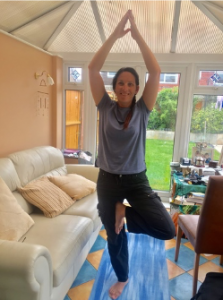
I knew that before I could achieve anything I had to work on my balance. However, I had been advised that I should do nothing – yes, absolutely nothing – for the first 6 weeks, and then gradually reintroduce exercise. There were a number of serious risks of complications from my surgery, the most concerning of which was CFS leak from the wound. In plain English, that’s a brain juice leak and something that would require further surgery and leave me at extreme risk of contracting meningitis. At the time of my surgery, I had also received a fat graft from my stomach to plug the hole in my skull, so I had the double whammy of a stomach wound to contend with too.
I worked on standing poses where I remained upright putting no pressure on my head, with a chair at my side for support. It was so difficult and frustrating, but rather than get hung up on what I couldn’t do, I tried to focus on the progress I was making and what I could do. I would practise yoga for minutes at a time, several times a day, with lots of sleep in between. There was progress, but to me it was never quite enough.
I took on an even bigger challenge about a week later. My husband Neil had been out cycling with friends and left his bike out in the garden. I looked at it and couldn’t help but wonder, would it really be as hard or impossible as I’d been told? I tried to sit on it, but it was too high, so I asked Neil to lower the seat. I think he said something along the lines of I should wait a few weeks, but then gave in. With the seat dropped to the lowest position possible, and with a couple of patio chairs for support, I sat on the bike. Just like walking had been, it was though I had never ridden a bike before.
I sat there unable to even contemplate pedalling. Instead, I pushed myself along like a toddler learning to ride for the first time. I pushed myself up and down the patio, eventually able to get one, then both feet on the pedals. It would have been so easy to just give up after my first attempt to even mount the bike, but by thinking outside the box a little, I was able to find a way to re-learn an old skill.
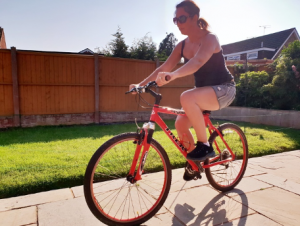
A week later, 3 weeks since my surgery, we took the bikes to an unused lane where, with the seat still in a low position, I was able to pedal for half an hour or so, perfecting the art of actually pedalling. It was exhausting as since surgery, I feel like I am constantly correcting my balance. My hands were sore and felt bruised from gripping so tightly to the bars for fear of coming off.
5 weeks after surgery, I rode 10 miles with a reward of coffee and cake half way. This was the week that my brain also remembered how to write (again this needed practice!) and the first time I met with friends from an outdoors club we belong to, to go for an evening walk. It was a really hot day and by the end of it, I was half expecting to end up in hospital the following morning with a leaking head.
At 6 weeks, I had my follow up with my surgeons. They were pleased with my progress not to mention a little shocked/surprised when I told them about the bike ride the previous day. I asked if I would be ok to take part in activities at altitude, to which the answer was yes, and I was cleared to run and told that I could start climbing again in a few months.
So, we drove back from Salford and I went for a run. Ok, I use the word ‘run’ rather loosely here. As I tried to run, objects in front of me wobbled around as my eyes still weren’t tracking together. That said, I run/walked 3k and felt pretty chuffed with myself.
The race was just a fortnight later, 8 weeks after surgery. It was scorching, with temperatures in the high 20s. It started from the grassy racecourse, which didn’t do much to help my balance and nausea. Again, it was a run/walk effort, with my friend Sahra alongside for support, and to keep me in a straightish line, as I now had a tendency to drift to the left, sometimes gradually but occasionally it was sudden and unexpected, for the runner alongside, as well as for me! I finished in the amazing time of 39 mins. The time meant little though, as I was just grateful to be there and able to take part. I also raised around £500 for Cancer Research UK.
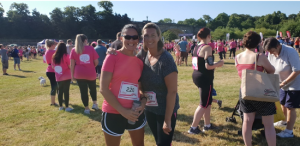
Our outdoors club had organised a hike in a Snowdonia a couple of weeks later, 6ish miles, with a sharp ascent and scramble through Devil’s Kitchen up to Cwm Idwal and then a more gradual slog up to the summit of Y Garn. It was another hot, humid day. I discovered that day, that scrambling made me nauseous. It seemed to be triggered by the head movements involved in looking for hand and foot holds. I was a bit disappointed with myself that day. I was frustrated with how much harder and more taxing everything seemed to be now. As I approached the summit, I had to take a breath, have a word with that nagging voice in my head and remind myself that just 10 weeks ago I couldn’t walk a metre on my own.
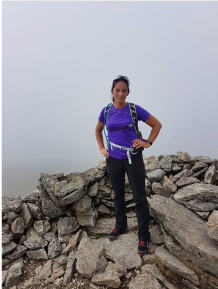
In true Snowdonia style, there were no summit views that day, just thick humid air, cloud and flies… lots of flies. I didn’t hang around too long before starting what for me was a slightly treacherous descent. I was slow pleased to get back down.
The next challenge I gave myself was slightly different. I wanted to reach new heights, but chose a slightly more extreme way of getting there… in a light aircraft attached to a parachute. Previously, I had been paragliding in the Alps, but I’d never skydived. To be honest, it was one of those things I’d wanted to do for years but never got around to. Of course, when you’re told you will need brain surgery, all of a sudden those things you wanted to do take on a much greater importance, especially when you think you won’t be able to do them as you have a fat filled hole in your skull! Anyway, I contacted Scott, one of my surgeons who thought I was crazy but commended me on doing this as I was raising funds for North West Air Ambulance.
The big day arrived, and we drove up to Skydive School in Lancaster. I didn’t feel nervous at all, as to be honest I doubted it would go ahead due to bad weather, the remnants of a named storm that had hit the northwest the previous couple of days. However, as we got closer, the skies began to clear and we were blessed with relatively clear skies and very little wind.
My tandem instructor Ben was great. He kept asking if I was nervous. Actually, I was feeling unusually calm, serene almost! I think that once you have lived through the prospect and experience of brain surgery, the bar was lifted on the levels at which I begin to feel afraid. The only thing that made me nervous, was the thought of not hearing any instructions being given to me. The more I engaged in everyday life, the harder I was finding it to deal with hearing loss. Some situations were harder than others; filtering out background noise was physically impossible and so the prospect of aircraft and wind noise was a little disconcerting.
Ben was really reassuring though and went through everything with me before we got in the plane. As we took off, the only sign that I had any adrenaline in my system was a dry mouth, and that too could have been put down to surgery, which had left me with no taste buds or sensation in half my face and mouth.
We were first on and last off. We shuffled along the bench and onto the floor before sitting in the doorway. It was so surreal looking out, knowing there was nothing beneath me but 15,000ft of air. Before I knew it we were out. It was incredible. The first few seconds were a bit weird, as we seemed to go out headfirst, but I kept my neck and legs bent right back, like a banana, and as the small drone shoot deployed our position became more stable.
The 60 seconds of 125 mph freefall was awesome, and once the ‘chute was deployed, we slowed suddenly. The incessant roar of the wind stopped, and Ben went over our landing procedure a couple more times before giving me a guided tour of the local landmarks, Blackpool tower being one of them glistening in the autumn sunshine.
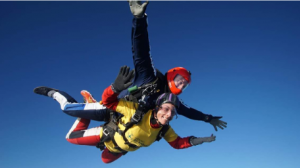
There was an illusion of increasing speed as the ground rushed up to meet us. I followed Ben’s instruction of “legs up” and we came to land, avoiding the massive puddle in the middle of the field. It was the most amazing experience, but whilst it was an adrenaline rush, it didn’t give me quite the sense of achievement I was hoping for. I hadn’t actually had to do anything, other than get out of the door…
I had spent the entire summer working to improve my balance and fitness, but was still struggling with fatigue and other issues. What’s more I was craving a challenge. We decided to head back to Chamonix, which in recent years has become a bit of a stomping ground for us. We booked to go in October, and arrived in glorious weather.
I discovered a lot that week. I found that whilst I could climb ladders up a rock face, my endurance levels had plummeted. A ridge walk we had completed previously, had to be aborted before we reached halfway as we were in danger of losing light. The stunning views were ruined by feeling utterly sick with exhaustion. The bikes we hired to hit the mountain biking trails were wasted as I suffered motion sickness riding on uneven terrain. I couldn’t ride uphill because as we slowed, I didn’t have the momentum to keep myself upright. We went back to our room, and I slept, for hours. Our final day was ruined when I fell quite spectacularly cutting my knee and wrecking my favourite pants. Travelling home, I was beginning to resign myself to the fact I would have to accept the new normal whether I wanted to or not.
My physical and mental health took a bit of a turn for the worse in the subsequent months. My progress curve had not only flattened, but was now sliding back down. I was beginning to worry that maybe I’d had some regrowth of the tumour so I went back to my GP who ran a load of blood tests on me. Turned out that my iron levels were through the floor, so that certainly wouldn’t have helped. Despite being prescribed heavy duty iron supplements, it would be Christmas time before I felt any benefit.
One cold, wet, windy, miserable winter’s day between Christmas and New Year when we met up with our club friends for a bit of a walk. Once again, I struggled with uneven, muddy, slippery ground. I didn’t want to go, in fact a deciding factor would be whether or not I could actually fit in my walking pants as sitting around had taken its toll. Thankfully I just about got in them, and in the company of good friends, I soon forgot about the awful conditions and just enjoyed being out. It’s funny how sometimes those runs, rides or hikes that you absolutely dread the prospect of turn out to be quite enjoyable. I think it was during this walk that the next mad plan, I mean goal, was hatched…
The following June we were spending a week in Yorkshire. It was decided that whilst we were there, a bunch of us would make our attempt on the Yorkshire 3 Peaks. That is the peaks of Pen-y-Ghent, Whernside and Ingleborough that form part of the Pennine range, encircling the head of the valley of the River Ribble in the Yorkshire Dales National Park. It was a route of 24 miles and included 1585 metres of ascent. The challenge element was that we had to complete this in under 12 hours.
With my sights zeroed in on my new target, the rest of the winter was spent getting miles and hills in my legs. Whatever the weather, I was out there in the Clwydians or Snowdonia We had pretty decent snowfall so headed up at night for the added vestibular therapy courtesy of Mother Nature, as for high winds, we took that too as extra resistance training.

At home, I continued to work on my balance, but had been referred for specific vestibular rehab therapy with a specialist physio.
Whilst I was a little dubious at first, and desperate to spend as much time away from hospital appointments as possible, Steph my physio was great. She listened and really took on board the problems I was having. We devised various creative exercises that would induce the feeling of nausea in order to retrain my brain to become less sensitive to it. Over time it really seemed to work. The downside to all of this is that with a brain injury like this, rehab exercises need to be on an almost daily basis in order to maintain progress. Like any training plan, you need to invest the time for results.
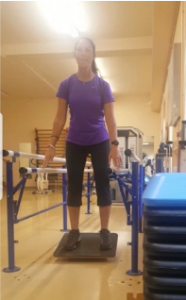
June was soon upon us, and we had prepared the night before for an early start. It was a typical Yorkshire weather day. The previous few weeks had been quite warm, but this particular day we had rain and wind forecast. As we left the bunkhouse and began our first speedy ascent of Ingleborough, it was relatively quiet, calm and dry. The summit looked other-worldly shrouded in mist, and having ticked off number one in one hour, we raced down towards the limestone pavement and headed towards peak number two, Pen-y-Ghent.
As we had eaten breakfast early, I was beginning to flag a little by the time we started our ascent. I fell behind and was worried that I’d be holding everyone else up, so armed with my map etc., I told them to go ahead and I would make my own way. One of our group Sue, decided to stay back with me. Although the cloud and rain was now beginning to close in on us, we took our time and began the final scramble to the summit. As it turns out, we weren’t far behind the rest of the group, so we had a five minute breather to hydrate and refuel and this made a huge difference. I think this had been my issue, so a lesson was learnt there.
We began the now busier descent from Pen-y-Ghent, and began the long trek to our final peak. The wet weather had now well and truly set in and there was little in the way of summit view. The rocks were slippery in parts so it was a relief to get down below the cloud and begin crossing mile after mile of open fields. It was incredibly muddy in parts which slowed us a little, but we were making good time.
As we approached the Ribblehead Viaduct, we stopped to grab a coffee and snack from a mobile café. I think it was called The Fourth Peak Snack Bar. I don’t remember much, apart from the lady working there living up to her reputation of being rather grumpy!
We then followed the viaduct and started our third and final ascent. There was quite a long approach to this one, and it the climb itself was a long, gradual slog. My energy levels were beginning to drop a little, so it was time to hit the caffeine gels, which seemed to do the trick, and I flew up the narrow path in no time! Again, we were greeted by low cloud and not much in the way of visibility from the summit. Pleased that we had completed our final peak ahead of schedule, we began the sharp, rocky descent; there was a brief glimpse of the greenery below through a brief break in the cloud cover but that was as good as it got!
For me, with tired legs, increasing fatigue and worsening balance, each step seemed, steep, slippery and precarious. I made sure to dig my poles in with each step and hoped they’d hold if I was to slip. Thankfully, we made it back to base in just over 10 hours. I had been so worried about this challenge, it felt like such an accomplishment to have completed it in under 12 hours.
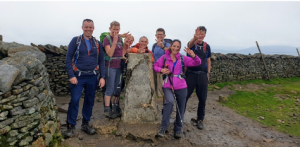
A few months later, we headed back to the Alps. I had a few demons to lay to rest after the previous disastrous trip. This time, I was really going to put my balance to the test…
I booked us a local guide to take us on a via ferrata route. The weather had been pretty appalling, but thankfully we had picked the best day for this.
Jean picked us up from our hotel and took us out of town. I had lied awake most of the night feeling physically sick with worry. What on earth was someone with half a vestibular system thinking of wanting to do this? I’d felt physically sick and spent most of the morning on the loo…
I knew I’d made things worse for myself by lying awake stressing over it, as I’d got up exhausted and was already at a disadvantage.
Jean had a story of his own. I had been somewhat taken aback when he picked us up and I realised he had lost most of all his fingers. As you can imagine, at this point all sorts of thoughts were rampaging through my mind! I asked him about his, and he explained that he had lost them to frostbite years earlier. He had been involved in a climbing accident on Mont Blanc. He had lost his footing and was left hanging upside down for some time, during which the freezing temperatures took their toll. He had taught himself how to tie knots and climb again.
The three of us headed to the rock face at Passey, and roped up and clipped on we began our climb. I had to remember to breath with each step I took, and can honestly say that my heart was well and truly in my mouth (and my stomach contents weren’t far behind) as we turned a corner and I saw the cable bridge ahead of us. I clipped on, took a deep breath and fixed my sights on a bit of green growing out of the rock ahead of us before taking my first step onto the moving cable. I’m pretty sure I was shaking the whole time it took me to get across, but again, knowing that I’d just done what others had said would likely be difficult, if not impossible, made it worth it. Watching Jean climb with no fingers was incredible. I am in awe of what he has achieved in the face of adversity.
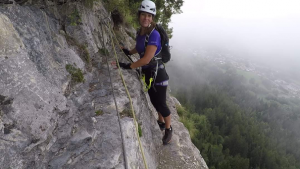
On our return to the UK, I was contacted by a friend who was off to climb Toubkal at the end of the month. A couple of the group she was travelling with had dropped out due to injuries and she asked if I’d be interested in going along.
Long story short, I didn’t need asking twice. There were a few logistics to sort out, but with just two weeks’ notice, I managed to get together everything I needed and headed off to Morocco.
I had met with Gwyn, an accomplished mountaineer and medic who would be travelling with us. When I presented him with an A4 sheet detailing my medical history and medication list, I was half expecting him to not allow me on the trip, but I was wrong.
Neil drove me to meet up with Cerries, Gwyn and Jay before heading to the airport. I think I cried all that day. I gave myself every possible reason not to go; Since my surgery I struggled with airports because of the noise and volume of people and I was worried about not traveling with Neil as he knew me well and knew when I was finding things hard. I felt incredibly under prepared because of the short notice, what if I couldn’t keep up because of my fatigue? What if I slipped and injured myself – what would medical facilities be like there? What if struggled with the altitude? What if… what if… what if? But niggling in the back of my mind was “What if I could actually do this?”
As our landcruiser headed up into the mountains that first night, and as we reached the point where we ran out of road and had to make our way on foot, I looked up to be greeted by more stars than you could every imagine, and a picture book view of the milky way high above us. It took my breath away; it was at that moment I knew that I was ready to do this.
Led by our guide Lehsan, we set off early the following morning, followed by our mules. It was hot, around 40 degrees, but it was a dry, bearable heat. Gwyn was on my case to remind me to keep sipping water as that would help with fatigue and any effects of altitude. The scenery was stunning. The rocky paths were quiet. I loved the solitude of these mountains.
What struck me most, was how happy people were. They had none of the luxuries we are accustomed to, and yet everyone whose path we crossed was smiling and happy. This will stay with me for a long time.
Our first night was spent at a very basic refuge. We slept in the roof space whilst down below, our team worked hard to prepare meals and supplies for us. After a wonderful carb and protein loaded breakfast, we set out early the next morning to Toubkal base camp. It was long day. I think the emotion of the days leading to our departure, the sensory overload at the airport and not sleeping in my own bed, and apprehension about summit day was all beginning to take its toll.
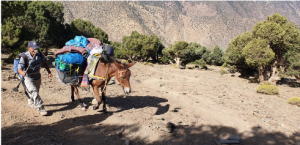
About an hour before we reached base camp, we dropped down into a valley to be greeted by our muleteer and cook who had rustled up the most amazing tagine meal you could ever imagine. How he managed it with a gas bottle and few just a few utensils is beyond me. We sat eating and drinking freshly brewed mint tea, overlooking the valley with base camp just visible as a dot in the distance.
Dark cloud was passing through, and we watched as the rain fell far into the valley below, continuing out of sight towards Imlil village with just a few drops of rain reaching us.
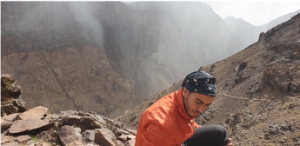
By this point, I was beginning to tire and was suffering with nosebleeds, apparently not unusual at altitude. I had a bit of a headache that felt slightly different to the usual ones, but increasing fluid intake seemed to help and it soon eased off. I was a little worried that if I mentioned this to Gwyn he’d tell me I couldn’t summit, but he was great and nothing but supportive. I knew he had his beady eye on me.
I was glad to reach base camp as it had been a very long day. Whilst it was isolated, it was almost like a mini village, or compound in the middle of nowhere. There was a great sense of camaraderie there, particularly with the guides, who all seemed to know each other and seemed pleased to meet up together.
We ate well that night at the refuge and prepared our gear ready for the next morning when we planned to leave out early. However, the 5am alarm call came at 3am when the French contingent who were sharing our room decided to get up and get their gear ready in the dorm with little consideration for everyone else who was wanting to sleep. Trying to think of expletives in a foreign language on 3 hours sleep wasn’t easy.
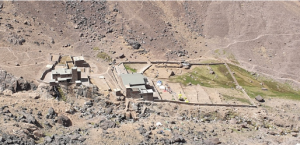
I lay there until 5am, hoping that rest would be just as good as sleep, and then got up, slipped into my gear that I’d left prepared at the end of my mattress and headed down for another hearty breakfast.
The first part of our ascent was a little bit of a scramble, with just the light of our head torches. Again, this was difficult for me but I’d done it before and this wasn’t going to stop me. With Lehsan leading the way, we hit the scree slopes just as the sun began to rise, silhouetting the high mountains around us. It was a beautiful sight. As we stood their looking across the valley, the mountains turned a beautiful orange and the sky a vivid blue. The silence was broken only by the distant roar of rocks falling.
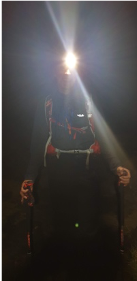
The scree slopes were tough for me. At times, it felt like I was trying to stay upright whilst walking on ball bearings. Again, my poles were great for digging in and giving me that extra bit of contact with the ground.
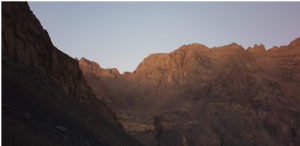
We made quite good time that morning and reached the summit by 10:30am. Gwyn had explained the route a little to me, and said that as the path seems to take a final turn back on itself, you see the pyramid at the top. I was up in front with Lehsan who, once we made that final turn, stepped aside to let me reach the summit first, on my own.
I don’t think I will ever be able to explain how seeing that pyramid against the deep blue sky made me feel. I could see it up ahead of me; it was so near and yet seemed so far. My breathing quickened as the emotion began to set in, and behind my sunglasses, I fought back tears from the one eye that still cries. I picked up my pace and had a bit of a moment when I reached the summit.
The others were a couple of minutes behind – they had wanted me to experience this on my own for a minute. When they reached the top, we hugged, we cried and we took in the most incredible views over the Sahara and the Atlas range. Gwyn told me later that day that he understood that I had been to hell and back as he had lost his mum, a nurse, to a brain tumour. He told me told me later that day after a somewhat slippery descent which resulted in a few falls and numerous bruises. I cried again, feeling a little guilty that I had survived what others haven’t, but proud that in just 506 days, I had gone from my sickbed to this summit. Toubkal had been on my to do list for a while. Being the first (but hopefully not the last) big climb since surgery, this will always be special to me.
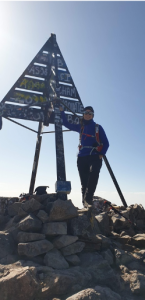
I love the mountains. They mean so many different things to me. I love the peace and solitude I find there. I love the silence – since losing my hearing they are a safe haven where I don’t have to worry about noise, and I love the challenges they present.
I feel lucky to still be here, and have made a promise to myself to make every day count for something. I still find silver linings. Whilst my diagnosis was devastating and life changing, and whilst I wish it had never happened, I feel blessed that it has changed my perspective on life in so many ways; only by going through an experience like this can you ever understand.
It has also presented me with many opportunities to give back to those who have supported me. I hope to continue fundraising for brain tumour charities, I still speak with people going through a brain tumour diagnosis, and I continue to share my story, through writing and speaking at schools and conferences, in the hope that it will raise awareness of this terrible disease and the impact of hidden disabilities.
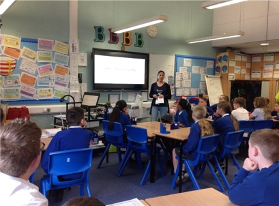
So the question now is, what next?
You can watch my journey here, and you can find out more about my fundraising adventures at www.saracrosland.com.

